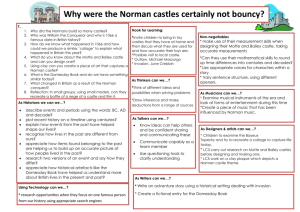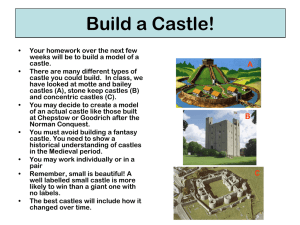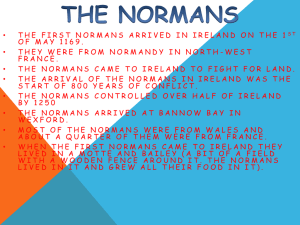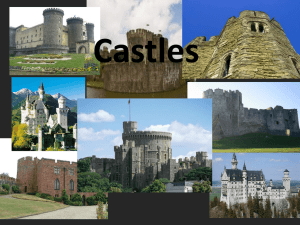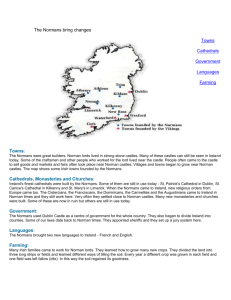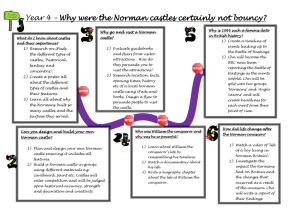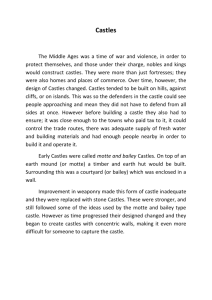Normans - duniryns.scoilnet.ie
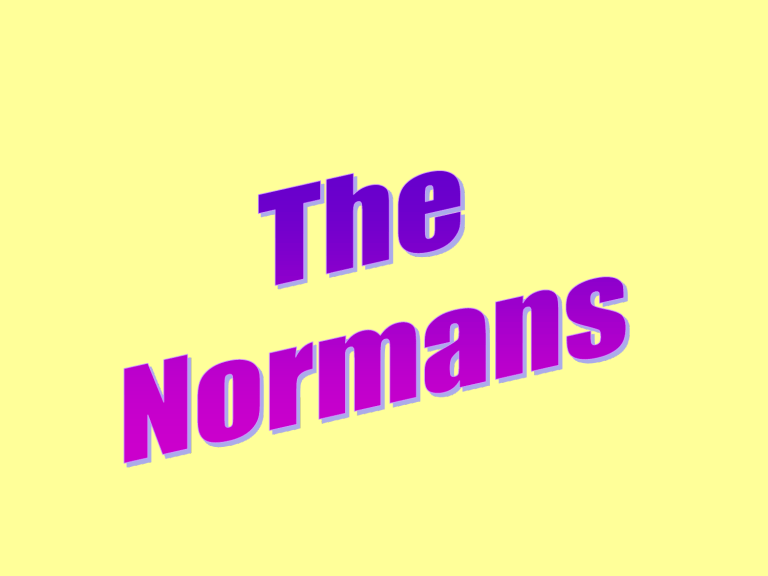
Who were the Normans?
The Normans were descended from the Vikings , who settled in Normandy, France. This is how they became known as the “Normans”. The local French People were left alone, so long as they provided their Norman lords with food, goods and work whenever they wanted it.
The Bayeaux Tapestry
After the Battle of Hastings in 1066, which resulted in the successful Norman conquest of England, William the Conqueror's wife, along with her many ladies in waiting, began working on a tapestry. The tapestry was designed to tell the story of her husband's successful invasion of England. There were 72 scenes.
Each scene told one piece of the story. William's wife and her ladies worked on the tapestry for 10 years.
When they were done, the tapestry was 20 inches high, and 250 feet long. The scenes were quite lively.
In one, men are standing in a boat, holding their hands up to their mouths, as if they are shouting.
Historians can tell a lot about daily life from the scenes on the Bayeux
. much more. All you can see in one scene is a group of horse heads sticking out of the top of a boat. But from this, historians can guess that horses were carried by boats to the battle.
During medieval times, tapestries were common. They were used to decorate castles and manor houses
Quick Bayeux Tapestry Facts
•It includes 623 people, 202 horses, 41 ships and 55 dogs
•There are more than 500 mythical creatures along the borders
•There are more than 2000 words
•It is made of a piece of linen (similar to tablecloth material), over 70 metres long, so it’s about the length of 3 swimming pools!
Why did the Normans arrive in Ireland?
In Norman times, Ireland was not a united country. It was more of a collection of smaller kingdoms that looked to an overall High King to settle disputes.
High Kings were chosen from the lesser kings, based on their wealth and their ability as warriors and leaders. This was not always a smooth process. Sometimes kings fought with each other to become High Kings.
Dermot MacMurrough
Diarmuid Mac Murrough
Strongbow
In 1166, the King of Leinster, Dermot
Mac Murrough, was forced to flee his kingdom by the new king Ruairí o
Connor.
Diarmuid then turned to the King of
England , Henry II, for help. Henry saw this as an opportunity to gain influence and power in Ireland so
Henry II gave Diarmuid permission to ask any of His Norman lords for help.
Diarmuid made a deal with Richard de
Clare, also known as Strongbow.
Strongbow agreed to help Diarmuid under certain conditions. Diarmuid promised he would give Strongbow his daughter, Aoifes, hand in marriage.
This meant that Strongbow would become the next king of Leinster.
Strongbow
The Marriage of Strongbow and Aoife
In 1169, the Norman knights and soldiers of Stongbow landed at Bannow Bay in Wexford. The Irish did not have as many arms and weapons as the Normans.
The following year, Strongbow himself arrived with an army of 1200 soldiers. After a bloody battle, he captured the city of Waterford.
Strongbow married Aoife and took control of Leinster.
Army
The Normans wore chain mail made of small linked iron rings.
A mail coat could weigh up to 14 kilogram's.
A padded garment called an aketon was worn underneath the mail.
The Normans had knights on horses with heavy armour lances and swords. They had archers who showered their enemies with thousands of arrows.
The Irish armies fought on foot and had only daggers, short5 spears and stones which they flung from slingshots. They thought it was cowardly to use armour and they fought in simple linen tunics.
The Capture of Dublin
When Diarmuid died, he kept his promise to Strong, and after marrying his daughter Aoife, he became King of Leinster in 1171.
Ruairi O Connor came to Dublin with his army and tried to recapture
Dublin
They managed to surround Dublin and kept it under siege for two months, hoping they would starve out the Normans.
The Normans , however, attacked Ruairi and his army who were defeated and Strongbow firmly remained as King of Leinster.
A Royal Visit
Henry II wanted to make sure that Strongbow was being loyal to him so he came to visit Ireland in 1172. Henry proclaimed himself “Lord of Ireland” and he granted
Strongbow the title of “Lord of Leinster”.
Henry II appointed Hugh de Lacy as his viceroy. This means that Hugh was in charge and did the work of the king while Henry was out of the country.
Motte and Bailey Castles:
•When the Normans captured an area they built a fort or castle where they would be safe. They were called motte and bailey forts and they were often built on a river bend or near a large town. They were usually built on high ground where they had a good view of the surrounding countryside.
•They were located near one another so that the Normans in one fort could send signals to their neighbours nearby.
First a large amount of earth was dug up and raised into a great mound. This mound was called the motte. It had a flat top. A simple wooden house with two or three rooms was built on the flat top. This was called a tower-house or keep. The lord and his family lived here.
It was surrounded by a wooden fence.
The bailey was at the base of the motte. It had many buildings. The lord's workers, soldiers and craftspeople lived here. It also contained workshops and stables. The bailey was also surrounded by a strong wooden fence. The motte and bailey was surrounded by a wide ditch full of water. This was called a moat. It had a drawbridge.
As time passed the wooden buildings in the motte and bailey rotted away or even burned. Today all that remains is the mottee
Motte and Bailey
The Earliest Castles were built very quickly – sometimes in just a few days.
At first they used earth and were known as motte and bailey castles because they had two main features. A large mound of earth (the motte) was constructed and a wooden tower was built on top. Below the motte was the bailey. This was a large open space, with a ditch and a fence around the outside.
Wooden tower.
Why build a tower out of wood?
Bailey . What would you find here?
Motte. Why bother building such a big mound?
Ditch.
How could a ditch stop people?
Bridge.
How did the Normans stop the enemy using this bridge?
When the Normans arrived the first castles they built were wooden, motte
& bailey castles (above.) Make a list of the advantages & disadvantages of this type of castle.
Stone Castles
Later, the Normans built fine stone castles. They had become expert castle builders. Years of attacking other peoples settlements had taught them how bets to defend their own.
A stone keep was the central feature, with thick walls and few windows. Entrance to the keep was by stone steps leading to the first floor. The kitchens were situated on the ground floor while living quarters were on the upper floors. The first keeps were rectangular in shape but later ones were often circular. The Stone Keep would be surrounded by a thick stone wall containing turrets for lookouts.
The Bailey was now the area outside the keep but within the outer walls and shelter for animals or craft workshops might be built against the walls. The entire castle might be surrounded by a ditch or moat and entrance to the castle was by drawbridge.
King John's Castle - History
Today, English Town, on the
King’s Island, is at the heart of
Limerick’s medieval core. King
John’s Castle is located here, on the southern bank of the
River Shannon, a little above the Curraghgower Falls. It was built to defend the river boundary and bridge between the Gaelic kingdoms to the west and the Norman kingdoms to the east and south. King
John’s Castle acted as a watchdog on sailors and cargoes. It was also the administrative and military centre for the Norman kingdom of Limerick.
King John’s Castle was built in the early years of the thirteenth century, probably between 1200 and 1210. It was a strong royal fortress built to withstand the power of new siege machines. It is a five-sided castle, with high curtain walls surrounding a rectangular yard.
The lower part of the walls was curved outwards to deflect missiles dropped from the battlements. Its massive gate towers and round corner towers were state-ofthe-art features at the beginning of the thirteenth century. The corner towers jutted out to allow archers to fire on attackers in crossfire. Only part of the gatehouse survives. In its early years King
John’s Castle was probably surrounded by a moat, with a drawbridge leading from the double-towered gatehouse to a foregate or barbican.
Cooking at the Castle:
Most of the food was cooked over a huge blazing fire so cooking was hot sweaty work. ( The fires in King John's kitchens were big enough to roast two whole oxen at the same time. Kitchens were a serious fire hazard so they were in separate buildings away from the main hall.) Everything from stews to puddings was boiled in huge metal cauldrons.
Sometimes meat was roasted over the fire on a hand-turned spit. The servant boy who had to turn this spit used an old, wet archery target as a fire screen. Bread and pies were baked in an oven, which was often built into the wall near the main fireplace.
Life in the Castle
The Rooms in the Keep:
The basement contained store-rooms and dungeons where prisoners were kept.
A spiral staircase led from the basement to the battlements around the roof. Soldiers kept watch over the surrounding countryside from here.
The entrance to the keep was on the ground floor. This was the guard room and the kitchen . The soldiers and servants spent most of their day here. They slept here, on the floor, at night.
On the first floor was the great hall . The lord conducted his business from here. He also held court and banquets here.
The top floor contained the lord and lady's private chapel and the great chamber. This was the lord's private room and it was more than just a bedroom. (Their beds were very comfortable. They had linen sheets and woollen blankets and the mattresses were filled with feathers.)
The lord's wife, the lady, spent much of her day here.
This is where she met visitors and gave orders to the steward, the man who managed the castle household. The great chamber was also a private space, where the lady and her ladies-in-waiting would embroider, make music or play chess.
Normans Names
Many Irish family names are Norman. Here are just some.
• Fitzgerald, Fitzpatrick, Fitzsimons, Fitzhenry,
Fitzmaurice, Prendergast, Roche, Neville, Sinnott,
Walshe, Barry, Butler, Burke
1. Describe the deal Strongbow made with Diarmuid and how was this arrangement also an advantage for King Henry II?
2. Do you think the Normans were welcomed when they first came to Ireland? Why?
3. What was the First kind of Castle? How was it Built?
4. Why do you think there are no remains left of any Norman wooden buildings?
5. Make a list of all the buildings in the castle and say how each one is important
6. Describe the Bayeaux Tapestry.
7. Briefly describe the events that led to the Norman invasion of Ireland.
8. Who would they Normans defend their castle in the event of an attack?
